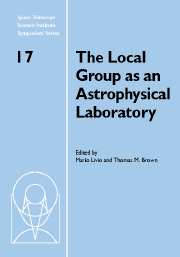 The Local Group as an Astrophysical Laboratory
The Local Group as an Astrophysical Laboratory Book contents
- Frontmatter
- Contents
- Participants
- Preface
- History of the Local Group
- Primordial nucleosynthesis
- Galactic structure
- The Large Magellanic Cloud: Structure and kinematics
- The Local Group as an astrophysical laboratory for massive star feedback
- Hot gas in the Local Group and low-redshift intergalactic medium
- Stages of satellite accretion
- The star formation history in the Andromeda halo
- Bulge populations in the Local Group
- The Local Group as a laboratory for the chemical evolution of galaxies
- Massive stars in the Local Group: Star formation and stellar evolution
- Massive Young Clusters in the Local Group
- Magellanic Cloud planetary nebulae as probes of stellar evolution and populations
- The old globular clusters: Or, life among the ruins
- Chemical evolution models of Local Group galaxies
Stages of satellite accretion
Published online by Cambridge University Press: 12 May 2010
- Frontmatter
- Contents
- Participants
- Preface
- History of the Local Group
- Primordial nucleosynthesis
- Galactic structure
- The Large Magellanic Cloud: Structure and kinematics
- The Local Group as an astrophysical laboratory for massive star feedback
- Hot gas in the Local Group and low-redshift intergalactic medium
- Stages of satellite accretion
- The star formation history in the Andromeda halo
- Bulge populations in the Local Group
- The Local Group as a laboratory for the chemical evolution of galaxies
- Massive stars in the Local Group: Star formation and stellar evolution
- Massive Young Clusters in the Local Group
- Magellanic Cloud planetary nebulae as probes of stellar evolution and populations
- The old globular clusters: Or, life among the ruins
- Chemical evolution models of Local Group galaxies
Summary
The Galaxy's extended halo contains numerous satellites which are in the process of being disrupted. This paper discusses the stages of satellite accretion onto the Galaxy with a focus on the Magellanic Clouds and Sagittarius dwarf galaxy. In particular, a possible gaseous component to the stellar stream of the Sgr dwarf is presented that has a total neutral hydrogen mass between 4–10×106 M⊙ at the distance to the stellar debris in this direction (36 kpc). This gaseous stream was most likely stripped from the main body of the dwarf 0.2–0.3 Gyr ago during its current orbit after a passage through a diffuse edge of the Galactic disk with a density > 10−4 cm−3. This gas represents the dwarf's last source of star formation fuel and explains how the galaxy was forming stars 0.5–2 Gyr ago. This is consistent with the star formation history and H I content of the other Local Group dwarf galaxies.
Introduction
Our Galaxy has built itself up by accreting satellite galaxies. This process if evident today through the satellites currently found in the extended Galactic halo. There are nine satellite galaxies within 150 kpc interacting with our Galaxy at various levels. These are in order of distance (Grebel, Gallagher, & Harbeck 2003): the Fornax dSph (138 kpc), the Carina dSph (94 kpc), the Sculptor dSph (88 kpc), the Sextans dSph (86 kpc), the Draco dSph (79 kpc), the Ursa Minor dSph (69 kpc), the Small Magellanic Cloud (63 kpc), the Large Magellanic Cloud (50 kpc), and the closest example of a recognizable accreting satellite is the Sagittarius Dwarf (28 kpc; hereafter Sgr dwarf).
- Type
- Chapter
- Information
- The Local Group as an Astrophysical LaboratoryProceedings of the Space Telescope Science Institute Symposium, held in Baltimore, Maryland May 5–8, 2003, pp. 100 - 110Publisher: Cambridge University PressPrint publication year: 2006


